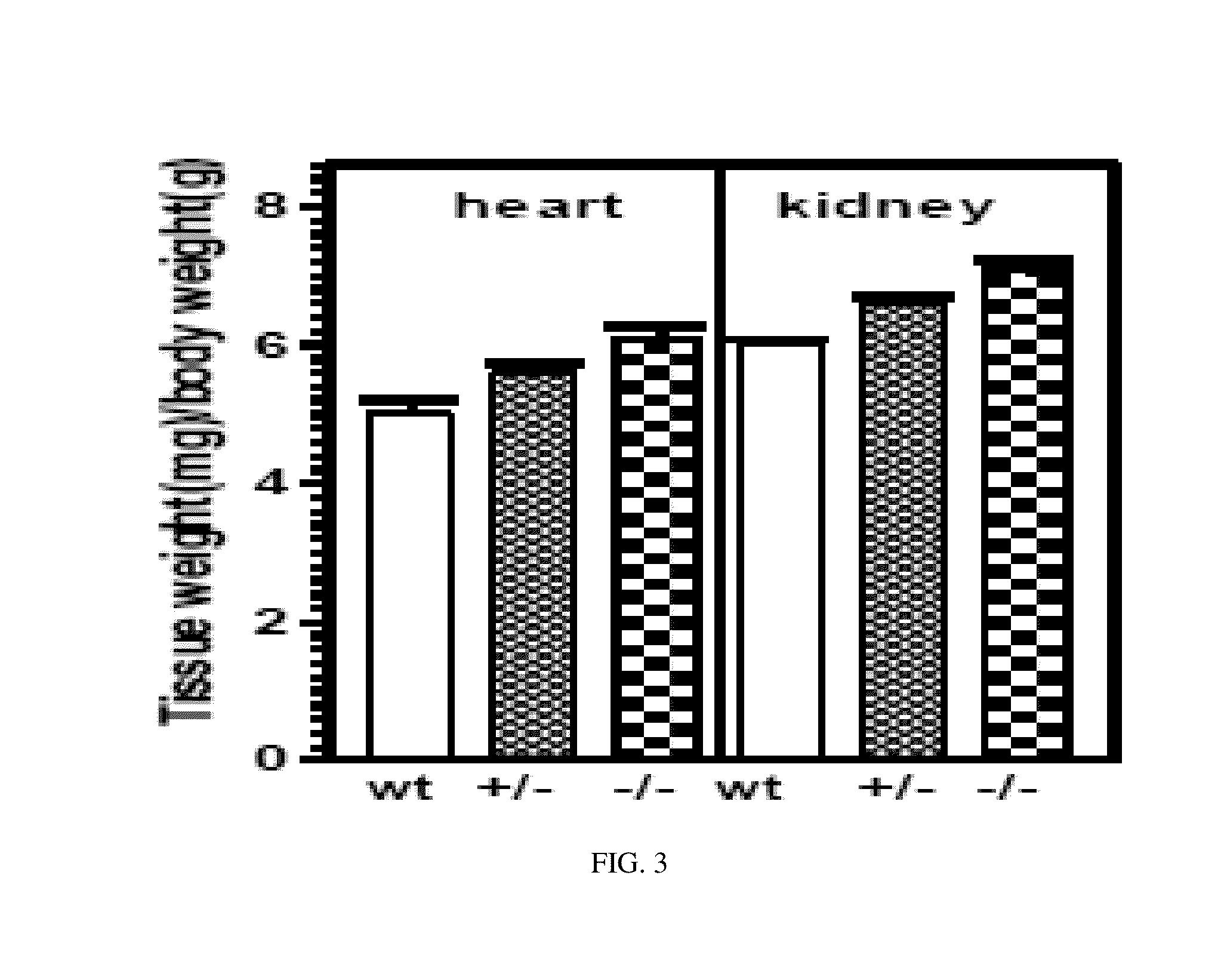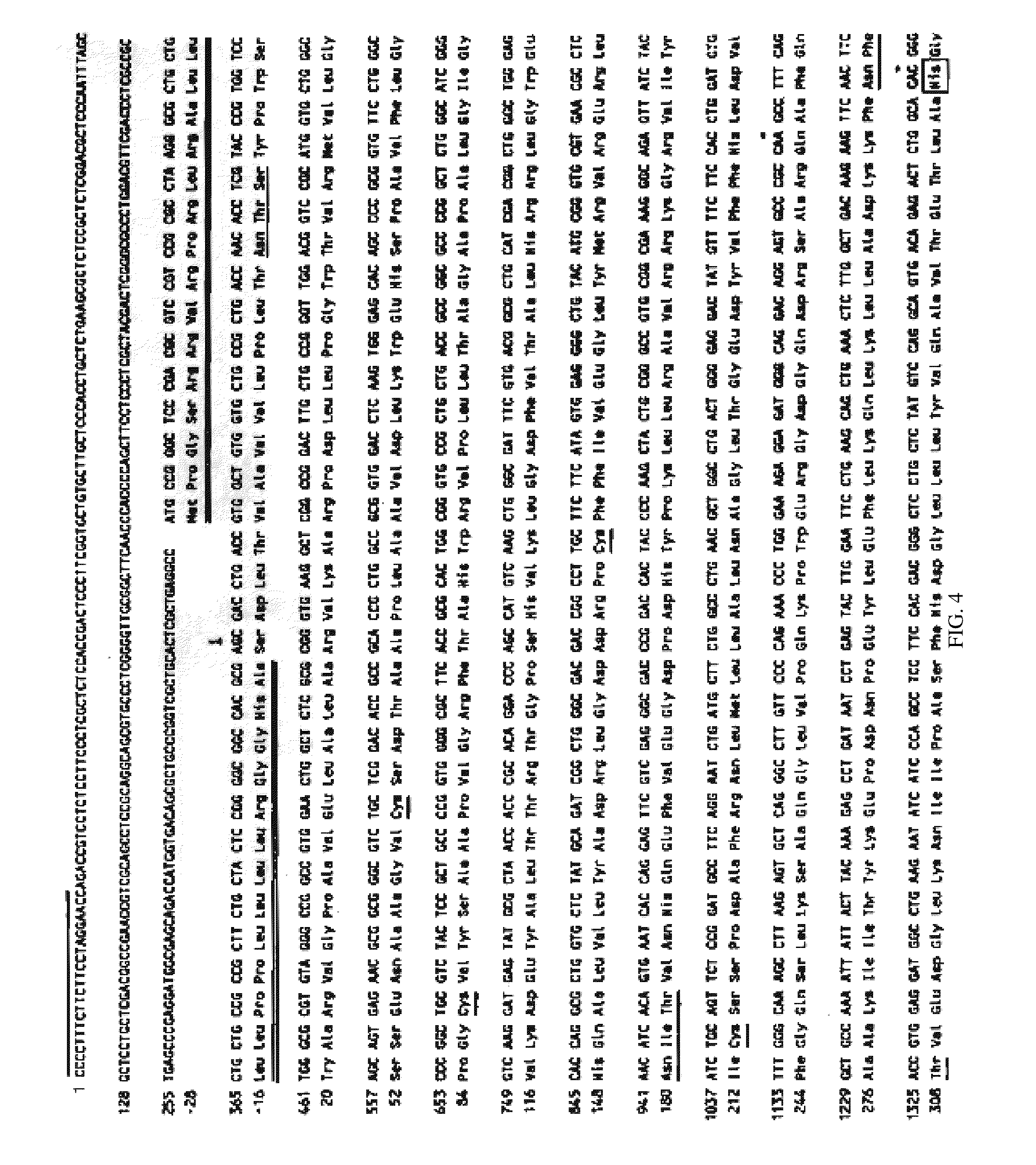ANF-RGC in-gene knock-out animal
a technology of in-gene knockout and anf-rgc, which is applied in the field of transgenic animals, can solve the problems of hypertension or high blood pressure in the animal model, reduce the cyclic gmp production, and achieve the effects of little or no anf-rgc activity, reduced cyclic gmp production, and reduced activity
- Summary
- Abstract
- Description
- Claims
- Application Information
AI Technical Summary
Benefits of technology
Problems solved by technology
Method used
Image
Examples
example 1
Generating Transgenic Mouse Lacking the ATP-ST Region of ANF-RGC
[0039]Two fragments (5′ arm and 3′ arm) of the mouse ANF-RGC gene were amplified from the mouse genomic DNA by PCR. They comprised the following genomic sequences: 5′-arm: from intron 8 to intron 13; 1800 bp (part of intron 8, exon 9, intron 9, exon 10, intron 10, exon 11, intron 11, exon 12, intron 12, exon 13, part of intron 13); 3′-arm: from intron 13 to intron 18; 2570 bp (part of intron 13, exon 14, intron 14, exon 15, intron 15, exon 16, intron 16, exon 17, intron 17, exon 18, part of intron 18).
5′-arm: Sequence(SEQ ID NO.: 6)GGCTGATGAGTTAGCGGAAGCTTCTAGATGAGGTGACTCACCCGGACCCAGGACTTGGGTGGTTAAGATAGGAAGATCTTGCTGTAAGTCTGAGGCTAGCCCATCCGTCTCTCATAAAACCAGAGCCAAACAAAAGAACAGGCTAACCCCCAGCTCTGCCTTCACTTGCTCACTCTGACATTGTCTTAAGTGAGGGTTGCAGTTACAGCCTCTGTAACAAGGCCCTCTCAAAGGTCAAATGACATAGTCTAAGTAAGCACGCAGGTATGAGTCTAATACACTACACAAAGGCGGGTGGGAGCTGGCATGGGTAGCTTACACCTGCAATCATTACTACAAGTTCAGGCAACCCTGAGCTAAAGAGTGAGAGCCTCTCTCTGCAAGGTAACAGATAA...
example 2
669WTAPELL675 Null Mice ANF Loses the Control Over Adrenal, Renal and Cardiac Activities
[0048]Heart, kidneys and adrenals were removed from 6 weeks old wt, (669WTAPELL675)+ / − and (669WTAPELL675)− / − female mice. The particulate fraction of each organ was prepared and analyzed for basal (B) and ANF / ATP-stimulated (S) guanylate cyclase activity. Mean±SD of three assays for each organ is shown in FIG. 2.
[0049]The animals from Example 1 were sacrificed and the tissues, heart, kidneys, and adrenal glands were removed from each animal. The tissues were quickly frozen in liquid nitrogen, powdered by mortal and pestle, and homogenized in 50 mM Tris-HCl / 10 mM MgCl2 buffer pH 7.4, aliquoted and stored at −80° C. until used. On the day of the experiment an aliquot of the particulate fraction suspension of each tissue (heart, kidney, and adrenal gland) from every animal [wild type, (WTAPELL)+ / −, (WTAPELL)− / −) was thawed and 2.5 μl of the suspension was assayed for guanylate cyclase activity in a...
example 3
Absence of the 669WTAPELL675 Motif in ANF-RGC Gene Causes Cardiac and Renal Hypertrophy
[0051]The animals from Example 1 were sacrificed and the total body weight of each animal was determined. The tissues, heart and kidney, were removed from each animal and their weight was determined. The ratio of the tissue (heart or kidney) weight (in mg) to body weight (in g) was calculated.
[0052]There was a significant difference in the ratio of heart or kidney weight to body weight between the mice with the 669WTAPELL675 signaling null-motif and the control wt-ANF-RGC. FIG. 3 demonstrates the ratio of the heart or kidney weight (mg) to body weight (g) of 6 week old female wt, (669WTAPELL675)+ / − and (669WTAPELL675)− / − mice. (Mean±SD of three measurements is provided). As illustrated, the number of ANF-RGC gene copies with the 669WTAPELL675 motif deleted determined this ratio, which was 5±0.25 [0 copies (wt)] and 6.1±0.25 {2 copies (669WTAPELL675)− / −]} for the heart; 6.0±0.1 (0 copies) and 7.1±0...
PUM
| Property | Measurement | Unit |
|---|---|---|
| Fraction | aaaaa | aaaaa |
| Fraction | aaaaa | aaaaa |
| Fraction | aaaaa | aaaaa |
Abstract
Description
Claims
Application Information
 Login to View More
Login to View More - R&D
- Intellectual Property
- Life Sciences
- Materials
- Tech Scout
- Unparalleled Data Quality
- Higher Quality Content
- 60% Fewer Hallucinations
Browse by: Latest US Patents, China's latest patents, Technical Efficacy Thesaurus, Application Domain, Technology Topic, Popular Technical Reports.
© 2025 PatSnap. All rights reserved.Legal|Privacy policy|Modern Slavery Act Transparency Statement|Sitemap|About US| Contact US: help@patsnap.com



